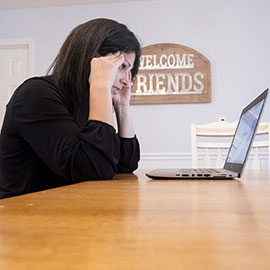Is It Safe to Detox from Drugs or Alcohol at Home?

November 02, 2023
The initial step in substance use disorder treatment is detoxification, or clearing the body of the alcohol or drugs to begin the recovery process. Addiction medicine specialists usually recommend medically supervised inpatient care, not at-home detoxification.
Withdrawal symptoms can last from a few days to at least weeks depending on the substance. Detoxing under the watchful care of trained professionals may be a life-saving strategy for safe and effective experience.
“Addiction is a medical condition, rather than a life choice, and we should all applaud and support anyone seeking to change their life. Medically supervised and medically assisted detox provides a safe environment for the critical first step in recovery,”says psychiatrist Tony Issac, M.D. “Detoxing at home by yourself or with a relative may be a well-intentioned but risky choice. If severe withdrawal symptoms or a medical emergency arises, nobody will be able to manage them.”
Alcohol Detox Symptoms
Some people consume alcohol continually, so some alcohol is always present in the body. During detox, a variety of symptoms may arise as alcohol clears from the body.
Alcohol-related withdrawal symptoms may be mild or severe, depending on factors like:
- How long you have been drinking
- How much alcohol you consumed regularly
During detox for alcohol use disorder, symptoms may include:
- Irritability or agitation
- Anxiety
- Headache
- Dizziness
- Vomiting
- Diarrhea
- Muscle pain, weakness, tremors
- Nausea
- Sweating
- Insomnia
- Seizures
- Visual or auditory hallucinations, such as threatening voices
- Tactile hallucinations (such as bugs crawling on skin)
- Frightening, vivid dreams or nightmares
- Delirium tremens, a group of symptoms that may be life-threatening
Delirium tremens (or the DTs as they are commonly known) symptoms include:
- Anxiety attacks
- Depression
- Confusion, disorientation and agitation
- Balance problems and loss of coordination
- Sleep difficulties and nightmares
- Hallucinations that cause fear or terror
- Excessive sweating
- Increased pulse rate and elevated blood pressure levels
- High fever
Because delirium tremens may be life-threatening, these symptoms require immediate medical care. Patients are typically treated in the intensive care unit.
Doctors use intravenous medication, vitamins and fluid to manage delirium tremens symptoms. For patients with high fevers, cooling blankets may help.
“Within a week or less, delirium tremens symptoms tend to fade away,” Dr. Issac says. “Trying to detox at home may be a fatal mistake because of delirium tremens.”
Sedative Detox Symptoms
Benzodiazepines and other sedatives may cause physical dependence in a short time frame. Withdrawal from sedatives may be life-threatening, similar to alcohol withdrawal.
Doctors recommend against a home detox for benzodiazepines or other sedatives. In the event of an emergency, immediate life-saving care is needed.
Symptoms are worse during a “cold turkey” detox. Doctors may recommend withdrawing from the drug on a tapered schedule, under medical care.
During a detox for sedatives, symptoms may include:
- Anxiety
- Irritability
- Sleep difficulties
- Upsetting dreams
- Increased heart rate
- Rapid breathing
- Confusion
- Seizures
Some who detox from sedatives experience life-threatening symptoms similar to delirium tremens. For this reason, doctors recommend hospitalization during this type of detox, not home detox.
Opioid Detox Symptoms
Opioids can cause dependence or addiction in a short period – even prescription opioids. People who have taken large doses for longer periods may experience stronger withdrawal symptoms.
Detoxing from opioids can cause a number of unpleasant symptoms. However, an opioid detox is rarely life-threatening.
For some people, detoxing from opioids as an inpatient is the best option. For others, supervised outpatient detox may work, which means detoxing at home.
Doctors often prescribe medication to make a supervised, at-home withdrawal easier to endure. Some prescription medications are given in place of opioids, then tapered down safely.
During a detox for opioids, symptoms may include:
- Anxiety
- Cravings for the drug
- Rapid breathing
- Increased hyperactivity
- Stomach cramps
- Goosebumps
- Sweating
- Watery eyes and a runny nose
- Increased yawning
- Body tremors
- Muscle spasms or twitches
- Nausea or vomiting
- Diarrhea
“The concern of at-home opioid detox is whether uncomfortable symptoms will prompt relapse,” Dr. Issac says. “And after any detox, relapse may be a concern.”
While at-home detox is currently not generally advised by addiction experts, there are innovative approaches being developed that may one day change what is possible. The advancement of remote monitoring in combination with office or home visits and Medically Assisted Treatment (MAT) may make safe and effective home detox a reality for many.
If you or someone you love is in need of detox treatment, don’t hesitate to reach out for support – clinical professionals are here to help you make the best decision for you.
Next Steps & Resources:
- Meet our source: Tony Issac, M.D.
- For admissions information about Blake Recovery Center at Carrier Clinic inpatient detox and rehab services, call 800-933-3579.
- To make an appointment with an addiction specialist or behavioral health specialist near you, call 800-822-8905 or visit our website.
The material provided through HealthU is intended to be used as general information only and should not replace the advice of your physician. Always consult your physician for individual care.





